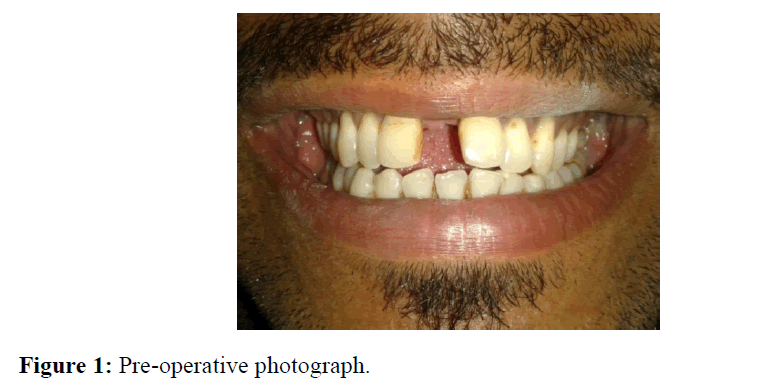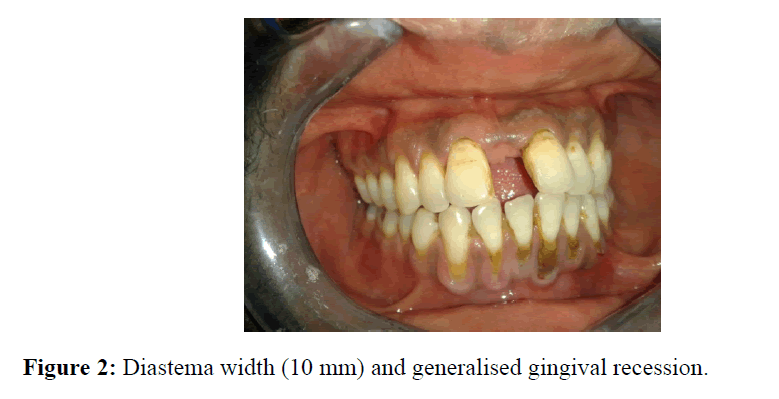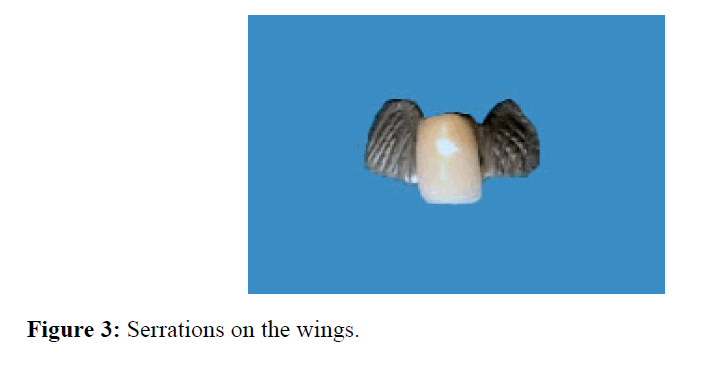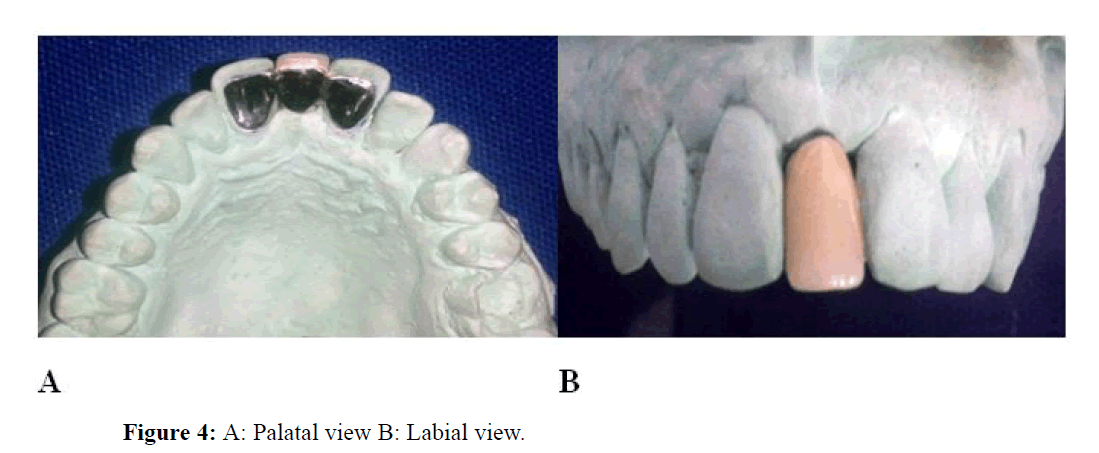Resin Retained Bridge a Treatment Modality for Diastema Closure: A Case Report
Abubakkar Mohammad Kinchanakodi, Mallika Shetty, Katheesa Parveen, Shamshad, Suhaim
Abubakkar Mohammad Kinchanakodi1,2*, Mallika Shetty2, Katheesa Parveen2, Shamshad2, Suhaim2
1Thumbay Hospital Gulf Medical University, Al Quasais, Dubai-48450, United Arab Emirates
2Department Of Prosthodontics, Yenepoya dental college, Mangalore-575018, India
- Corresponding Author:
- Abubakkar Mohammad Kinchanakodi
Thumbay Hospital Gulf Medical University, Al Quasais, Dubai-48450, United Arab Emirates
Tel: 00971526463469
Fax: 00971562623578
E-mail: drabuvasthare@gmail.com
Abstract
Midline diastema can be treated by various treatment options like composites, veneers and orthodontic treatment, in this case due to the excess space between the central incisors, composites and veneers were not the ideal treatment options. So a modified resin bonded fixed partial denture was used. Resin bonded fixed partial denture is a conservative approach to the replacement of missing teeth. It is a provisional treatment until the patient undergoes permanent treatment.
Keywords
Resin retained bridge, Diastema, Resin cement
Introduction
Midline diastema (MD) is spaces of varying magnitude between the crowns of fully erupted maxillary and mandibular central incisors.[1] The presence of diastemas in the anterior aesthetic zone can be displeasing to a person’s smile and many patients are motivated to improve their appearance either with orthodontic treatment or restoratively with veneers, crowns, and/or composite resin bonding.[2]
Resin bonded fixed partial dentures are a conservative approach to the replacement of missing teeth and for esthetic anchorage for removable partial dentures.[3,4] The technique has several advantages over conventional dentures including conservation of tooth structure and reduces cost.[5]
Case Report
A 34 year old male patient was referred to vast hare dental speciality clinic, Uppala, Kasargod, Kerala, India, with a chief complaint of space between the upper front teeth (Figure 1). He was wearing a removable partial denture since 5 years, which was fractured. Now the patient wanted a fixed prosthesis. On examination there was a diastema of 10 mm width. Generalised stains and gingival recession was present (Figure 2). Overbite was less than 1 mm. Diagnostic impressions were made and treatment was planned. Orthodontic treatment was suggested but since was leaving abroad he wanted an Immediate treatment. He was a removable partial denture wearer for 5 years and was satisfied with his appearance. So it was decided to give him a resin retained fixed partial denture which would give him a similar look.
Procedure
Periodontal treatment was advised, but the patient was not willing for the same. So the treatment began with shade selection followed by tooth preparation. Depth orientation grooves were placed on the palatal cingulum surface using no.1 round bur (1 mm diameter) and reduced with the wheel diamond to provide 0.5 mm clearance. Preparation is terminated 1.5 to 2 mm from the incisal edge. Proximal reduction was done with round and tapering diamond just lingual to the contact point. Supra gingival Chamfer finish line was given. Final impression was made using irreversible hydrocolloid impression made (Tropicalgin, Zermack).
Wax pattern was made and casting of the metal frame work done. Serrations were made on the intaglio surface of the wings of the metal frame work with diamond wheels to enhance the retention (Figure 3) following which the fit of the frame work was checked. Ceramic build up was done (Figures 4A and 4B). The prosthesis was then cemented using self-adhesive resin cement (RelyXTMU200) (Figures 5A-5C). The patient was advised oral hygiene habits and was recalled for check-up.
Discussion
Resin retained fixed partial dentures are indicated in missing anterior in children and adults, in short span bridges, splinting periodontally weak teeth, medically compromised patients, abutment with sufficient enamel to etch for retention.6 In this case the patient had sufficient enamel for bonding. The over jet and overbite was very minimal which helped in a conservative tooth preparation.
The advantages of resin retained fixed partial dentures are the conservation of tooth structure, preparation is confined to the enamel, tolerance to tissues with no pulpal trauma and supra gingival margins, provisional restorations are not required, less chair side time, does not require cast alteration or removable dies, rebounding is possible.[6] Diastemas can treated by Composite (direct and indirect), veneer, orthodontic treatment.
In this case composite was not possible because the space between the two central incisors were more. If composite build up was done it would look broad mesiodistally and would not be esthetically acceptable. In addition the strength of the restoration would be compromised. Veneer was not attempted because of the increased mesiodistal width and the treatment cost.
The fixed prosthesis constructed in this case is a modification of the Rochette Bridge. Serrations were made on the intaglio surface of the wings of the metal frame work instead of multiple flared perforations. The serrations enhanced the retention by increasing the surface area for the luting cement. This simple chair side technique is time saving. Retention of the post was improved by using the resin cement and by increasing the length.
Conclusion
Ideal treatment for a midline diastema is orthodontic or composite or veneers. Resin retained fixed bridges are indicated in short span edentulous case. In this case it was used as a temporary or provisional treatment until the patient goes for permanent treatment.
References
- Sushil K. Midline diastema closure with direct-bonding restorations. Cosmetic Dentistry 2010; 1: 6-11.
- Christopher CK. Diastema closure with a micro-hybrid composite resin. Dental Practice 2006; 3: 156-160.
- Kerschbaum T., Haastert B., Marinello CP. Risk of de-bonding in three-unit resin bonded fixed partial denture. J Prosthet Dent 1996; 75:248-253.
- Ketabi AR., Kaus T., HerdachF. Thirteen year follow up study of resin bonded fixed partial dentures. Quintessence Int 2004;35: 407-410.
- El-Mowafy O., Rubo MH. Resin retained fixed partial dentuers: A literature review with presentation of a novel approach. IntJProsthodont 2000; 13:460-467.
- Vanthompson. Contemporary fixed Prosthodontics. 3rd edition Harcourt publishers, 2002: p 680.
Open Access Journals
- Aquaculture & Veterinary Science
- Chemistry & Chemical Sciences
- Clinical Sciences
- Engineering
- General Science
- Genetics & Molecular Biology
- Health Care & Nursing
- Immunology & Microbiology
- Materials Science
- Mathematics & Physics
- Medical Sciences
- Neurology & Psychiatry
- Oncology & Cancer Science
- Pharmaceutical Sciences





